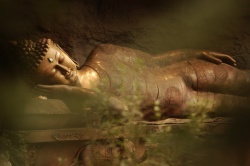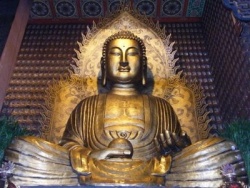Several key roles that the principle of emptiness plays on the Bodhisattva's grounds in the Madhyamaka tradition
The principle of emptiness played an important role in the main ideas of the Buddhist teaching. With the development of the Mahāyāna tradition emptiness became the central pillar for philosophical concepts within the Madhyāmāka school and gave rise to many disputation among other schools. Karma Phuntsho [1] outlines in his article several important roles that the principle of emptiness played in the Buddhist doctrine, epistemology and history. Some of these roles can be spotted also in the Mipham’s commentary to "Introduction to the Middle Way” [2] by Candrakirti. In this blog post I will show some of these roles of emptiness and connect them to their principles explained or emphasized by Mipham.
1. Emptiness as selflessness: realization on the grounds
It is said that all sentient beings travel in samsaric existence due to perceiving internal and external phenomena as inherently existent. In his article, Karma Phuntsho bases on Nagārjuna’s statement saying, that karma and rebirth exist as long as there is grasping to the self which, in turn, depends on perception of the five aggregates. Thus if five aggregates are seen as being empty of inherent existence, the grasping at self will cease to arise and consequently one will liberate from the cyclic rebirth in samsara. This is the view of emptiness that eliminates grasping to one’s self.
Mipham addresses selflessness in reference to level of realization of Bodhisattvas on different grounds. He explains that Bodhisattvas on the first ground see emptiness directly. This is realization of emptiness of the five aggregates and it occurs at this stage only at the time of meditative equipoise. Self grasping is eliminated and Bodhisattvas are able to give away everything, material possessions and even their physical organs . From further explanation of Mipham, we can understand that seeing emptiness during meditative equipoise is not the complete realization of selflessness. He explains that this level of realization comes only on the third ground. At that stage, the wisdom of emptiness burns completely the clinging to self at the time of meditative equipoise and this experience continues in the post meditation. He clarifies that Bodhisattvas on the third ground begin to experience selflessness of external phenomena. Such experience occurs only in the state of their meditative equipoise. This is the view of emptiness that eliminates grasping to external phenomena.
Finally , Mipham introduces the forth ground where Bodhisattvas are fully liberated from clinging to self and they also achieve complete realization of selflessness of external phenomena. Thus Bodhisattvas at the fourth ground have perfect recognition that both, their own self as well as any external phenomena, are lacking inherent existence. Thus we can say that Bodhisattvas at this stage attained complete realization of two-fold selflessness.
2. Emptiness as Prajñāpāramitā: the mother of all Buddhas
The main practice in the Mahāyāna tradition is a gradual meditative training called the six perfections or pāramitās. The last of the 6 perfections is called pāramitā of wisdom or Prajñāpāramitā, which is the ultimate realization of emptiness. Karma Phuntsho presents the concept of Prajñāpāramitā to be related not only to emptiness but also to the non-conceptual wisdom which arises from experience of emptiness. Mipham explains that the other five perfections are actually included in Prajñāpāramitā when they are practiced without concept of the three spheres in the state of non-conceptual wisdom.
Other relation between emptiness and Prajñāpāramitā presented by Karma Phuntsho is view of Maitreya in Abhisamayālamkāra saying that Prajñāpāramitā is mother of all Shravakas, Pratyekabuddhas, Bodhisattvas and the Buddhas. Prajñāpāramitā sutras state, that all Buddhas are born from realization and practice of Prajñāpāramitā. Regarding this role of emptiness, Mipham explains that the Shravakas, who proclaim the Buddha Dharma to others, are born from the speech of the Buddha. Pratyekabuddhas who are superior to Shravakas’ realization are also born from the speech of the Buddha. The Buddha himself is said to be born from the Boddhisatva at the special moment of traversing from the final Bodhisattvas' tenth ground into the eleventh ground of the Buddhahood. Mipham concludes that in order to attain enlightenment all Shravakas, Pratyekabudhas and Bodhisattvas one must train in Prajñāpāramitā. Otherwise there will not a single Buddha who will be born.
3. Emptiness as the ultimate truth: seeing the nature of all phenomena
Karma Phuntsho presents the concept of the two truths: the conventional truth and the ultimate truth. He displays the ultimate truth as emptiness, which is the absolute nature of all things. Seeing all phenomena as being unreal and perceiving reality as an empty reflection is the view of emptiness. Perception of phenomena in other way then being empty is classified as the wrong view.
Mipham says that by power of wisdom on the sixth ground, Bodhisattvas master completely the two truths. They realize all phenomena as being empty of inherent existence and perceive them as mere illusions. Seeing the nature of things is the goal of the Bodhisattva because it is path to Buddhahood and condition to being able to lead other beings towards liberation . Karma Phuntsho defines emptiness as the essential condition for achievement of liberation . In this regard, Mipham explains that abiding in the ultimate nature of phenomena is attaining cessation, meaning attainment liberation from karma, rebirth and suffering. Such realization is fruition of seeing emptiness as the ultimate truth.
Even though Mipham does not refer to emptiness as a separate topic in first five chapters, he does mention it in various contexts. In this post, I outlined three roles of emptiness in the Buddhist tradition as presented by Karma Phuntsho, and provided evidences to the way they can be found in the Mipham’s commentary. It can be seen from these evidences, that emptiness as selflessness, as wisdom arising from experience of emptiness and source of all Buddhas, and as seeing the nature of all phenomena is indeed common and can be found in our text.
Notes:
[1] Karma Phuntsho's Mipham's Dialectic and the Debates on Emptiness
[2] Mipham’s commentary to Introduction to the Middle Way, Shechen Publication, India, 2010

